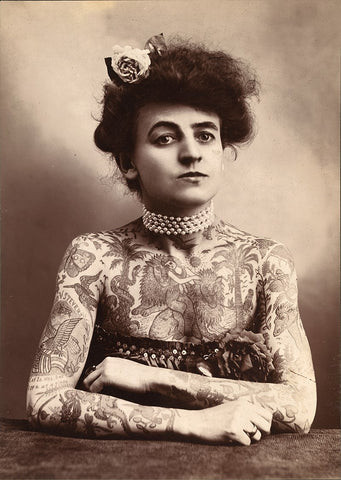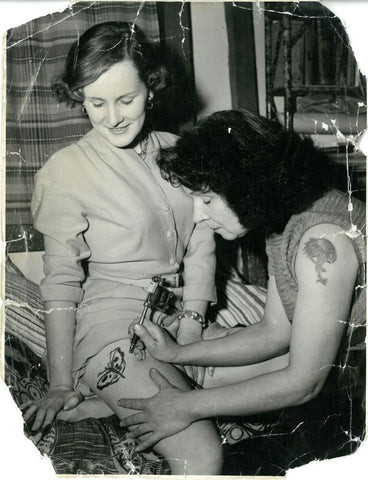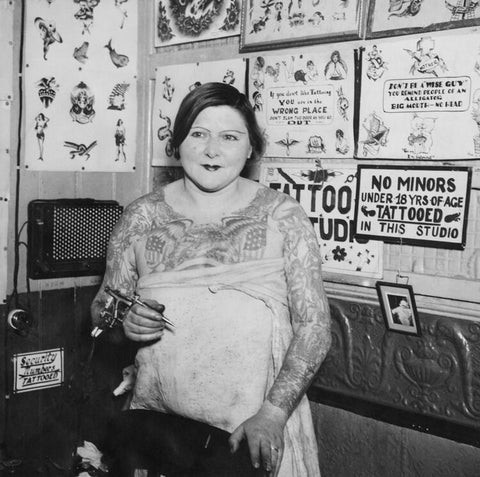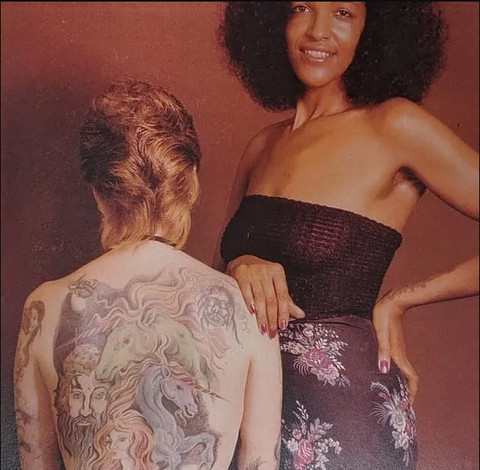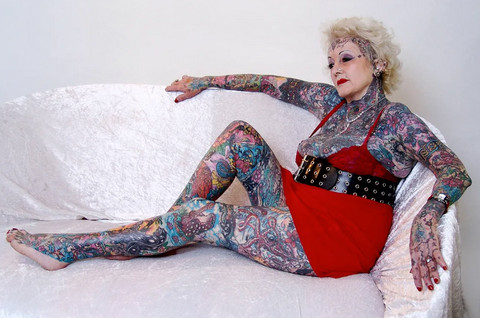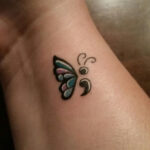Even in the early 2000s, choosing to get a tattoo felt like stepping outside the norm. The reaction of surprise, even shock, from some quarters highlighted how deeply ingrained societal perceptions were about women and body modification. However, the story of women and tattoos is far richer and more complex than fleeting trends or rebellious phases. As Margot Mifflin insightfully notes in Bodies of Subversion: a secret history of women and tattoos, tattoos resonate with contemporary women as powerful symbols. They represent both empowerment in an era marked by feminist progress and self-determination in a world where women are acutely aware of bodily autonomy amidst ongoing debates around reproductive rights and personal safety.
But to think of tattoos as a purely modern form of female expression would be a mistake. Delving into history reveals fascinating accounts, such as an 1879 article in The National Police Gazette of New York titled ‘The Tattoo Trick.’ This piece profiled an anonymous female tattoo artist working discreetly in a respectable neighborhood, noting the surprising success of her business amongst a primarily female clientele. These glimpses into the past ignite our curiosity. Who were these women who chose to adorn their skin with ink decades, even centuries ago? What drew them to tattoos, and what societal judgments did they navigate?
To understand the legacy of tattooed women, we need to look back at the pioneers who paved the way. These are the women who embraced tattoo art long before it gained mainstream acceptance, especially for women. From the early 1900s, when women faced significant limitations in their public and private lives, these figures defied expectations. They took control of their bodies and narratives through ink, contributing to a powerful and often overlooked chapter in tattoo history – herstory. Let’s explore the stories of some of these iconic women who helped shape the landscape of tattoos in women.
Maud Wagner: Circus Star and Tattoo Pioneer
Maud Wagner began her career in the captivating world of the circus as an aerialist and contortionist. Her life took a turn in 1904 when she crossed paths with tattoo artist Gus Wagner. Their courtship was unconventional: Maud agreed to a date only if Gus would teach her the art of tattooing. Marrying Gus Wagner, she embraced tattooing fully, becoming proficient in the traditional “stick and poke” method by 1907. Maud not only became a tattoo artist but also extensively tattooed herself, embodying the art form she practiced and becoming a powerful early example of women embracing tattoos.
Jessie Knight: Breaking Barriers in the UK Tattoo Scene
Jessie Knight holds the distinction of being considered the UK’s first professional female tattooist. Starting her tattooing journey at just 17 in 1921, Jessie learned the craft from her father, a sailor and tattoo artist. When he was away at sea, she took charge of his tattoo shop in Barry, South Wales, demonstrating early entrepreneurial spirit in a field dominated by men. To combat the societal stigma associated with female tattoo artists, Jessie adopted a professional image, always wearing a suit and maintaining immaculate hair. Despite facing prejudice, captured in her diary entries from the 1940s where she wrote about being called names, Jessie persevered. She tattooed well into the 1980s, managing multiple shops throughout her long and impactful career, paving the way for future generations of women in tattooing in the UK.
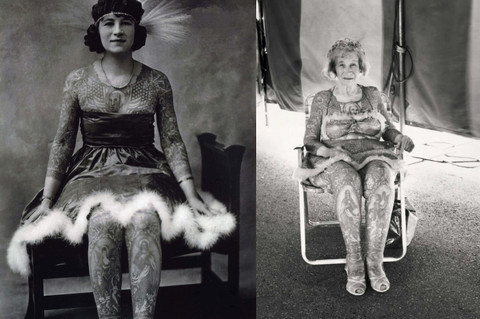
Artoria Gibbons: The Performing Tattooed Lady
Artoria Gibbons, known as the tattooed lady, crafted a compelling stage persona that captivated audiences for decades. Her introduction often involved a fabricated backstory: a tale of being tattooed against her will by a possessive older husband to deter other men. The reality was a partnership with her husband, Charles “Red” Gibbons, a well-known tattoo artist. Together, they recognized the performance potential of Artoria’s tattoos. Charles tattooed Artoria in vibrant color, covering her body with reproductions of her favorite religious artworks, including masterpieces like Botticelli’s The Annunciation and Michelangelo’s Doni Tondo. From the 1920s until her retirement in 1981, Artoria performed as a tattooed lady, skillfully blending performance art with body art and challenging societal norms around women’s bodies and public display.
Mildred Hull: New York’s Pioneering Female Tattooist
Mildred Hull, born in 1897 and known as Millie, was a former burlesque dancer who broke ground as one of the first women to become a tattoo artist independently, without relying on a male partner or relative for training. She tattooed a diverse clientele, with women frequently requesting sentimental designs like hearts enclosing lovers’ names and “mother” tattoos. In 1943, she was recognized as New York City’s only female tattooist, a remarkable achievement considering tattooing was illegal in NYC until 1997. In a Foto Magazine interview, Mildred noted a possible advantage to being a woman in her profession, suggesting, “I think men rather like having a woman tattoo them. They think a woman is likely to be more careful.” Despite her professional success, Mildred’s life ended tragically in 1947.
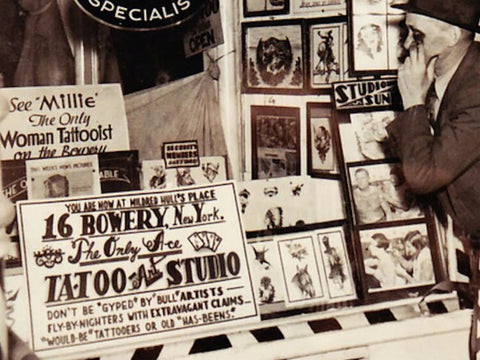
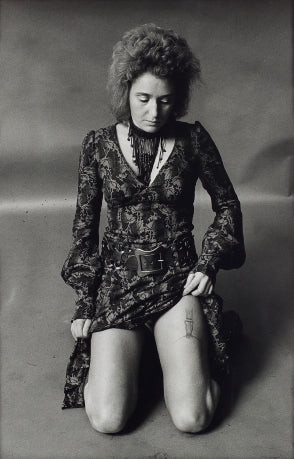
Valie Export: Tattoo as Feminist Statement
Valie Export, an Austrian avant-garde artist, used her body as a canvas for social commentary. In a 1970 public performance in Frankfurt, she tattooed a suspender belt onto her thigh. This wasn’t merely decorative; it was a powerful statement about the objectification of women. Valie saw tattooing as a ritualistic act connected to civilization, writing, “Tattooing the body demonstrates the connection between ritual and civilization. In the tattoo the garter appears as a sign of a past enslavement, clothing as the suppression of sexuality, the garter as an attribute of a femininity not determined by ourselves.” Her tattoo became a lasting symbol of feminist resistance and a critique of societal expectations placed upon women’s bodies.
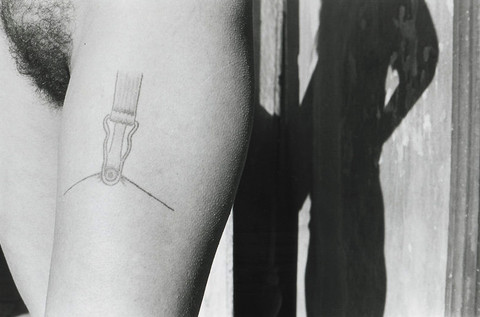
Jacci Gresham: Breaking Racial Barriers in Tattooing
Jacci Gresham is celebrated as the USA’s first Black female tattoo artist and a true icon in the tattoo community. Learning to tattoo in 1972, Jacci not only entered a male-dominated industry but also one overwhelmingly white. Her shop, Aart Accent Tattoos, established in New Orleans, holds the historic distinction of being the first tattoo studio opened by a Black woman in the United States. Jacci, still tattooing in her 70s, continues to inspire. Her shop’s slogan, “Look better naked – get a tattoo,” encapsulates the confidence and body positivity that tattoos can embody, and Jacci’s legacy is one of breaking barriers and promoting inclusivity within the tattoo world.
[
View this post on Instagram
](https://www.instagram.com/p/CBn-7beFMcq/?utm_source=ig_embed&utm_campaign=loading)[A post shared by Jacci Gresham (@aartaccenttat2)](https://www.instagram.com/p/CBn-7beFMcq/?utm_source=ig_embed&utm_campaign=loading)
Isobel Varley: Tattoo Addiction and World Record Holder
Isobel Varley’s tattoo journey began later in life, at age 49 in 1986. Initially intending to get just one small bird tattoo, Isobel described it as falling “in love with it, and developed an addiction.” This “addiction” led her to become famously tattooed, covering 93% of her body in ink and earning her the Guinness World Record for being the most tattooed female senior citizen. Over a decade, she amassed more than 200 tattoos, with a family of tigers on her stomach holding a special place among her extensive collection. Isobel Varley, who passed away in 2015 at 77, demonstrated that the allure of tattoos transcends age and can be a lifelong passion.
These women, through their ink and their actions, challenged societal norms and redefined the narrative around women and tattoos. Their stories are a vital part of tattoo herstory, reminding us that tattoos for women have long been a powerful form of self-expression, empowerment, and a bold statement in a world often seeking to define them. Their legacy continues to inspire women today to embrace tattoos as a means of personal storytelling and artistic freedom.
